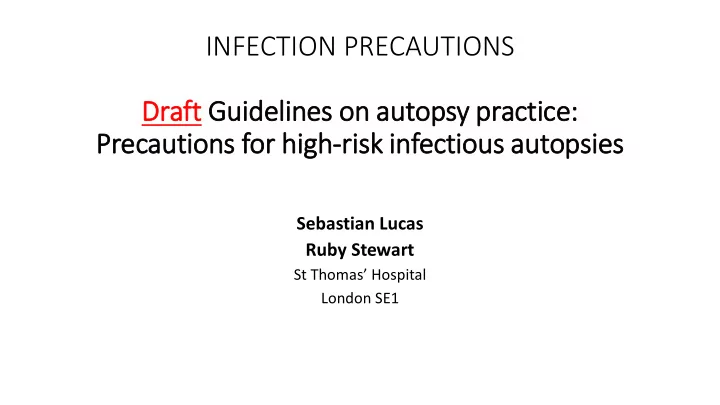

INFECTION PRECAUTIONS Draft Guidelines on autopsy practice: : Precautions for hig igh-risk in infectious autopsies Sebastian Lucas Ruby Stewart St Thomas’ Hospital London SE1
HIV + TB [Ruby & Ula Yellow Mahadeva] fever – post- vaccination
Health & Safety HG 2 & 3 infections HG 4 infections • HG2 – can cause human disease, • Cause severe human disease, unlikely to spread in community, likely to spread in community, treatable and preventable usually no prophylaxis or treatment available • HG3 – severe human disease, may spread to community, “usually effective prophylaxis or treatment available”
Health & Safety HG 2 & 3 infections HG 4 infections • HG2 – Streptococcus spp, • All viral infections – Lassa, Ebola, Leptospira, Nocardia, Legionella, Marburg, smallpox, Congo- syphilis, influenzas. Crimea • HG3 – Rabies, Yellow fever, HIV, • Do not get involved in these – hepatitis B/C/D/E, MERS, autopsies effectively banned in dengue; anthrax, tuberculosis, UK. plague; TSEs; imported mycoses. • These are manageable
Mortuaries in Africa – HIV/AIDS in the 1980s & 1990s
AFB HIVp24
Brief history of RCPath autopsy guidelines • On website: “Guidelines on autopsy practice, including best practice scenarios, from May 2010. Please note: a major programme is underway in 2016-17 to review all these guidelines - see the Autopsy guidelines page”. • Early 1990s: short pamphlets, conflating consented & medico-legal • 1998 • hepatitis mortuary story • Histopath SAC – chair James Underwood • 2002 – Guidelines on autopsy practice document • Steven Leadbeatter, Roger Start, Jem Berry, X McKenzie
The important issues – our view, but what have we left out or over-egged? 1. Suitable mortuaries and APTs 2. Suitable pathologists 3. Anticipation and SOPs for safe practice 4. Reasonable PPE 5. Diagnostic pathways to evaluate IDs in cadavers 6. Managing accidents • Implicit agenda: to promote specialist autopsy pathology wrt mortuary development, APTs and pathologists
1. Suitable mortuaries and APTs • Can all mortuaries cope with all infections? • Mortuary design, air flows, hygiene, accreditation • PPE available on site • Availability of specimen & blood culture bottles • Access to microbiology and histology laboratories • APT experience and confidence • Is there rapidly available OH advice in the event of accidents?
2. Suitable pathologists • Do you know about IDs and how to diagnose them? • Do you have access to appropriate histological special stains and microbiology diagnostics?
Issues 1 & 2 [point 4.4 in the Draft] • If all the boxes are ticked, go ahead • If mortuary/APTs not prepared – refer case elsewhere • If mortuary/APTs prepared, but pathologist not experienced ( or not prepared to learn ) – • Import someone who does know what to do • Or refer the case elsewhere
3. Anticipation and SOPs for safe practice • A good thing about accreditation • Levels of experience of APTs and trainee pathologists • Specification of PPE levels • Rules of behaviour at the mortuary table and dissecting bench • Blunt-end PM40 blades • Vaccinations for staff • Resident APTs • Resident pathologists • Resident trainees • Visiting pathologists and trainees
4. Reasonable PPE • Surgical scrub suit • Water-proof gown • Face mask – surgical or FFP3 • Blood-born agents – surgical mask • Air-born agents – tighter mask • Eye protection – goggles/glasses/full face visor • Gloves – cut-proof neoprene under rubber • For HG3 and perhaps all autopsies? • Hat • Steel-reinforced wellies
5. Diagnostic pathways to evaluate IDs 1. Known infections - Treated or not treated 2. Suspected infections 3. Unanticipated infections at autopsy The limitations of clinical information in life Each scenario process will depend on the actual agent • Post-vaccination fatality
5. Basic diagnostics • If local infection – sample for FFPE histology +/- microbiology fresh tissue • Special stains, IHC, ISH • PCR for many infections works in FFPE • If systemic infection and “sepsis ?cause” • Sample all major organs and lumbar bone marrow • Liver, spleen, large node, lungs, heart, kidney • Brain optional
5. Basic diagnostics • Consider autopsy dab cytology • It works for many bacteria and fungi • Air-dried slide & Giemsa / Gram / Grocott silver / ZN • Is it ‘tissue retention’?
HPC/HLH in bone marrow & liver CD68/PGM1
6. Managing accidents • Contamination with blood born viruses and bacteria (and malaria) • Cuts through gloves • Refer to OH • Hepatitis C • HIV • Post-exposure prophylaxis (PEP) and treatment • Test blood from the cadaver • Safety of staff trumps HTA, ethical and legal issues • Air-borne inhalation eg TB (retrospective) • Watch and wait
End of formal introduction Your questions, recommendations and objections
Nerdier aspects to consider for final Guideline? • Detailed information about more • When/how trainees get experience named infections – known & • Pregnant staff in mortuary suspected • Management (PHE, NHS, local) • Details on tissue sampling for more interfering with ID autopsy infections • More detailed risk assessments • Shorter lists of bugs • Staff: circulator needed? • Protection of visitors: undertakers, • Notification of IDs to local Health embalmers, students Protection team • More on PPE • Role of limited autopsy in ID • More or less on gross pathology encountered in ID cadavers • More or less on diagnostic cell path • Just limit Guideline to infection risk and microbiology and PPE for APTs and pathologists??
After this meeting….. Ruby and I will prepare the version to send out to RCPath membership for review & comment
Recommend
More recommend